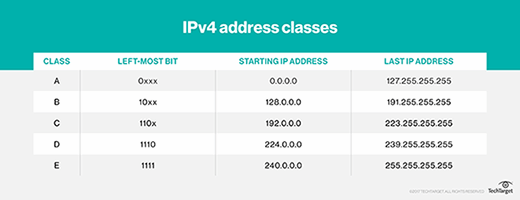
alphaspirit - Fotolia
What does the 0.0.0.0 IP address mean and why is it used?
One of a few special-purpose addresses, IP address 0.0.0.0 has several applications in networking. It stands in as a placeholder address, identifies a default route and more.
The IP address number 0.0.0.0 is a nonroutable IPv4 address with several uses, primarily as a default or placeholder address. Even though 0.0.0.0 has several uses on computer networks, it is not a general-purpose device address.
The Internet Engineering Task Force defines the IP address 0.0.0.0 as a reserved, special-purpose address for "this host, this network." Its IPv6 equivalent is expressed as ::/0. Although 0.0.0.0 is valid address syntax, a client device using it as a source IP address cannot communicate on a network.
IPv4 address numbers start with 0.0.0.0 and go up to 255.255.255.255.
What does a 0.0.0.0 IP address mean?
In the simplest terms, the IP address 0.0.0.0 means "this network," but it is not a usable address in the traditional sense. It is a little like a note that says, "Insert address here," or, depending on the context, "no specific destination address." It acts as a stand-in until a valid, routable IP address is assigned. It can appear as a result of an error or be assigned intentionally.
For example, if a device like a computer or printer is assigned the client IP address 0.0.0.0, it usually means the device is unable to connect to and communicate on a network. In other instances, such as routing, it is used intentionally as a default route when a more specific route to the destination address is unavailable.
What is 0.0.0.0 used for?
One use of IP address 0.0.0.0 is during system initialization, when a device adopts it before being assigned a usable IP address. Similarly, it can also display as a result of a Dynamic Host Configuration Protocol (DHCP) error. A Windows client that experiences this error and supports Automatic Private IP Addressing will assign itself an IP address within the range of 169.254.1.0 through 169.254.254.255. It will use 0.0.0.0 as the gateway address.
Other ways to use the IP address 0.0.0.0 include the following:
- As a default static route. In IPv4-based routing, 0.0.0.0 serves as a default route. This means no particular address has been designated in the routing table as the next hop in the packet's path to its final destination. When the default route is used with a subnet mask of 0.0.0.0, it matches any address. When used with a 255.255.255.255 mask, it matches none.
- On a LAN. Within a LAN, 0.0.0.0 can be used as a source address in IPv4 broadcasting, which is used to transmit data to all devices on a LAN.
- On servers. IP address 0.0.0.0 is used on servers to designate a service may bind to all network interfaces. It tells a server to "listen" for and accept connections from any IP address.
- On PCs and client devices. A 0.0.0.0 address indicates the client isn't connected to a TCP/IP network, and a device may give itself a 0.0.0.0 address when it is offline.

What is the difference between 127.0.0.0 and 0.0.0.0?
It is easy to confuse IP addresses 127.0.0.0 and 0.0.0.0, as both are considered class A, special-purpose IPv4 addresses that are used by hosts for self-identification.
Key differences
While 127.0.0.0 and 0.0.0.0 share some similar traits, the most notable difference between the two is their function. As previously stated, IP address 0.0.0.0 has several uses. However, 127.0.0.0 has one main purpose: It is reserved for loopback traffic -- that is, communications within a single host.
Understanding loopback traffic
IP address 127.0.0.0 is often compared to a closed circuit because any packet sent to 127.0.0.0 -- or any address in the 127.0.0.0-127.255.255.255 block -- will be returned to the same machine. Packets sent to 127.0.0.0 cannot enter a local network, and the transmission is managed by the host's OS, as opposed to the network interface card. As a result, 127.0.0.0 is typically used for testing and troubleshooting purposes. It is also known by the hostname localhost.
Addresses within the 127.0.0.0/8 block do not appear on a network. The IPv6 equivalent of 127.0.0.0 is ::1.
Troubleshooting 0.0.0.0 IPv4 addresses
If a computer is configured for TCP/IP networking and shows 0.0.0.0 as its IP address, the following troubleshooting steps can be taken to try to obtain a valid IP address:
- Release and renew the computer's IP address networks with dynamic IP address assignment support. Failures with DHCP assignments can happen repeatedly or intermittently. If valid IP address failures continue, check the DHCP server configuration because a common cause of failure includes having no available addresses in the DHCP pool.
- For networks that require static IP addresses, a valid IP address can be configured on the computer.







